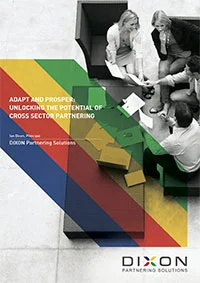Cross Sector Partnering is complex and challenging. Bringing people and organisations together from different sectors and keeping them together to deliver results is not easy.
In our experience much of the partnering we see today is ad hoc and does not follow a clear path, resulting in delays, extra costs, greater risks and less value add.
Our Partnering by Design™ methodology assists partners to co design innovative solutions to complex issues and challenges. It guides partners through their partnering process efficiently and effectively and forms the basis for the Partnering Essentials™ suite of programs
This methodology includes a number of models and frameworks such as our 3 stage DIXON Partnering Process™ – Creating, Developing and Sustaining.
Whitepapers
Some of our latest whitepaper publications available to download
'How to build effective partnerships between the Business, Government, Community and Education Sectors'
Today we are faced with many sustainable development challenges across the world, which if not addressed and resolved in some way will threaten our very existence. Climate change, energy shortages, droughts, poverty, environmental pollution, epidemics such as HIV and economic and social disadvantage are just some of those challenges.
Partnerships between business, government, community and education are critical to addressing these challenges and to achieving global sustainable development.
This paper addresses the key challenges faced when entering into a cross sector partnership, what it takes to develop an effective partnership that actually delivers real results and what are some of the critical components that need attention in the partnering process.
Adapt and Prosper: Unlocking the Potential of Cross sector Partnering
The time has come for dramatic change – a change we must embrace if we are to see results rather than rhetoric. This is reflected in the significant increase being observed in efforts for system reforms and innovation. To achieve this, however, it is crucial to understand that working with complex or intractable issues requires a different way of operating if a sustainable change is to be achieved. Partnering - specifically cross sector partnering - is the means to this end.
Over ten years worth of evidence, both anecdotal and empirical, demonstrates that cross sector partnering is being used more and more to find solutions to the significant challenges in the ‘too hard basket’; such as unemployment, poverty, pollution, an ageing population, economic pressures, and increasing productivity through innovation.
This paper addresses the challenges around maximising the potential and value from cross sector partnering and what it takes for individuals and organisations to set the right conditions for this to occur



